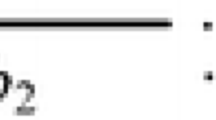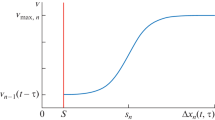Abstract
The responses of vehicles to the changes in traffic situations inevitably have delays in observing an event and implementing a control command, which often causes fatal accidents. So far, the methods for handling delays are empirical and cannot be mathematically proven. To eliminate the accidents caused by such delays, in this paper, we develop mathematically provable methods to handle these delays. Specifically, we use networked discrete event systems to model the process of driving vehicles and present a supervisory controller for handling delay situations. The method developed in this paper could serve as a new start for modeling and controlling the responsive behaviors of self-driving vehicles in the future.










Similar content being viewed by others
References
Ramadge, P. J., & Wonham, W. M. (1987). Supervisory control of a class of discrete event processes. SIAM Journal on Control and Optimization, 25(1), 206–230.
Lin, F., & Wonham, W. M. (1988). On observability of discrete-event systems. Information Sciences, 44(3), 173–198.
Cieslak, R., Desclaux, C., Fawaz, A. S., & Varaiya, V. (1988). Supervisory control of discrete-event processes with partial observations. IEEE Transactions on Automatic Control, 33(3), 249–260.
Wang, W., Lafortune, S., Lin, F., & Girard, A. R. (2010). Minimization of sensor activation in discrete event systems for the purpose of control. IEEE Transactions on Automatic Control, 55(11), 2447–2461.
Wang, W., Lafortune, S., Girard, A. R., & Lin, F. (2010). Optimal sensor activation for diagnosing discrete event systems. Automatica, 46(7), 1165–1175.
van Schuppen, J. H. (2004). Decentralized control with communication between controllers. In V. D. Blondel & A. Megretski (Eds.), Unsolved problems in mathematical systems and control theory (pp. 144–150). Princeton: Princeton University Press.
Wang, W., Lafortune, S., & Lin, F. (2008). Minimization of communication of event occurrences in acyclic discrete event systems. IEEE Transactions on Automatic Control, 53(9), 2197–2202.
Wang, W., Lafortune, S., & Lin, F. (2008). On the minimization of communication in networked systems with a central station. Discrete Event Dynamic Systems: Theory and Applications, 18(4), 415–443.
Wang, W., Lafortune, S., & Lin, F. (2007). An algorithm for calculating indistinguishable states and clusters in finite-state automata with partially observable transitions. Systems & Control Letters, 56(9), 656–661.
Wang, W., Lafortune, S., & Lin, F. (2011). On codiagnosability and coobservability with dynamic observations. IEEE Transactions on Automatic Control, 56(7), 1551–1566.
Yin, X., & Lafortune, S. (2015). Synthesis of maximally permissive supervisors for partially-observed discrete-event systems. IEEE Transactions on Automatic Control, 61(5), 1239–1254.
Yin, X., & Lafortune, S. (2015). A uniform approach for synthesizing property-enforcing supervisors for partially-observed discrete-event systems. IEEE Transactions on Automatic Control, 61(8), 2140–2154.
Yin, X., & Lafortune, S. (2017). Verification complexity of a class of observational properties for modular discrete events systems. Automatica, 83, 199–205.
Rolison, J. J., Regev, S., Moutari, S., & Feeney, A. (2018). What are the factors that contribute to road accidents? An assessment of law enforcement views, ordinary drivers’ opinions, road accident records. Accident Analysis & Prevention, 115, 11–24.
Lin, F. (2014). Control of networked discrete event systems: dealing with communication delays and losses. SIAM Journal on Control and Optimization, 52(2), 1276–1298.
Shu, S., & Lin, F. (2015). Supervisor synthesis for networked discrete event systems with communication delays. IEEE Transactions on Automatic Control, 60(8), 2183–2188.
Shu, S., & Lin, F. (2017). Predictive networked control of discrete event systems. IEEE Transactions on Automatic Control, 62(9), 4698–4705.
Theunissen, R. J. M., Petreczky, M., Schiffelers, R. R. H., Van Beek, D. A., & Rooda, J. E. (2014). Application of supervisory control synthesis to a patient support table of a magnetic resonance imaging scanner. IEEE Transactions on Automation Science and Engineering, 11(1), 20–32.
Forschelen, S. T. J., De Mortelfronczak, J. M. V., Su, R., & Rooda, J. E. (2012). Application of supervisory control theory to theme park vehicles. Discrete Event Dynamic Systems, 22(4), 511–540.
Su, R., Shehabinia, A. R., Gan, O. P., & Joe, Y. Y. (2013). Modeling and supervisory control of dynamic material handling systems. In Proceedings of the 32nd Chinese control conference (pp. 8336–8341). Xi'an: IEEE.
Reveliotis, S. (2013). Applications of discrete event systems. London: Springer. https://doi.org/10.1007/978-1-4471-5102-9_59-1.
Tako, A. A., & Robinson, S. (2012). The application of discrete event simulation and system dynamics in the logistics and supply chain context. Decision Support Systems, 52(4), 802–815.
Zou, W., Shi, P., Xiang, Z., Shi, Y. (2019). Consensus tracking control of switched stochastic nonlinear multiagent systems via event-triggered strategy. IEEE Transactions on Neural Networks and Learning Systems, 31(3), 1036–1045.
Zou, W., Xiang, Z., & Ahn, C. K. (2018). Mean square leader-following consensus of second-order nonlinear multiagent systems with noises and unmodeled dynamics. IEEE Transactions on Systems, Man, Cybernetics: Systems, 49(12), 2478–2486.
Cassandras, C. G., & Lafortune, S. (2009). Introduction to discrete event systems. New York: Springer.
Author information
Authors and Affiliations
Corresponding author
Rights and permissions
About this article
Cite this article
Liang, J., Gong, C., Hou, Y. et al. Application of networked discrete event system theory on intelligent transportation systems. Control Theory Technol. 19, 236–248 (2021). https://doi.org/10.1007/s11768-020-00002-2
Received:
Revised:
Accepted:
Published:
Issue Date:
DOI: https://doi.org/10.1007/s11768-020-00002-2




